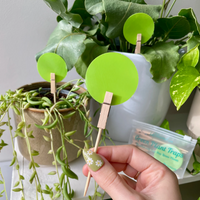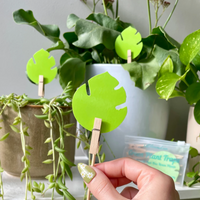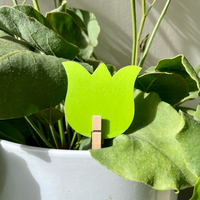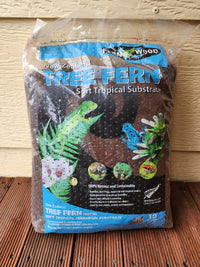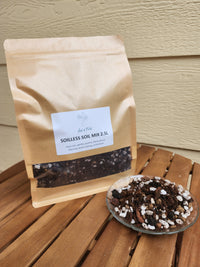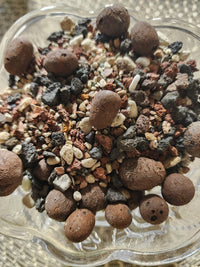Houseplants bring life and beauty to our homes, but what if you could have even more? Propagation, the art of creating new plants from your existing ones, allows you to multiply your plant collection and share the joy with family and friends. This article explores four popular methods: water propagation, LECA propagation, perlite propagation, and propagating directly into soil.
Water Propagation: A Classic & all Time Favourite
Water propagation is a simple and effective method for many plants, especially those with nodes (bumpy areas) on their stems. Here's how:
- Take a Cutting: Choose a healthy, non-flowering stem with at least 2-3 nodes. Using clean sterile trimmers, make a clean cut just below a node at a 45-degree angle.
- Strip the Bottom Leaves: Remove the lower leaves from the cutting, exposing the nodes.
- Watery Home: Place the cutting in a clean jar or vase filled with fresh, room-temperature water. Ensure only the bottom node(s) are submerged. For better results, place the jar or vase in a dark container so the roots are not exposed to light.
- Patience is Key: Change the water every few days to prevent bacteria growth. Within a few weeks, roots should begin to sprout from the nodes. Once you have roots growing, add a fertiliser such as Growth Technology Clonex Clone Solution, for an extra boost you can also add GT Rootzone. Starting with a lower dosage working your way up to the full dose. These will feed your cutting making it develop nice health roots.
- Potting Up: Once you have secondary roots that are 2-3 cm long, your plant is ready for its new home! Choose a clear nursery pot with drainage holes and well-draining potting mix.
LECA Propagation: Lightweight and Mess-Free
LECA (Lightweight Expanded Clay Aggregate) is a popular alternative to water propagation. Here's what you need:
- The LECA Setup: Wash your LECA thoroughly until clean water start to run through. It is good practice to soak your LECA overnight. This can be in just plain water, or a GT Clonex Clone Solution.
- Cutting Prep: Follow steps 1 and 2 from the water propagation method.
- LECA Landing: Place the LECA in a clear nursery pot, place your cutting in the LECA, ensuring the bottom one or two nodes are sitting in the LECA. Place your nursery pot in a container or a ceramic pot.
- Moisture Matters: Keep the LECA damp but not soggy. Add water to the container about ¼ of the way up the clear nursery pot. When the water level drops add more water. Ensuring a fertiliser is used, such as GT Clonex Clone Solution.
- Root Check: Monitor root development through the clear nursery pot. Once roots reach 2-3 cm, your plant is ready for potting in soil, or you can continue growing it in LECA as a semi-hydro plant. Remembering to always feed your plant. Using GT Clonex Clone Solution when it’s a cutting and GT Foliage Focus when it’s a fully grown plant.

Perlite Propagation: Airy and Efficient
Perlite, a volcanic rock with excellent drainage, offers another option. Here's how to use it:
- Perlite Prep: Wash your perlite thoroughly to get rid of the dust and to moisten your perlite. Fill a container with the moistened perlite. This could be a cup or a clear nursery pot.
- Cutting Ready: Follow steps 1 and 2 from the water propagation method.
- Planting Time: Make a hole in the perlite and insert the cutting, ensuring at least a node is buried.
- Watering Wisely: Add water to your perlite, just a little bit at the bottom. Once the water dry, add some more. Avoid adding too much water as it can lead to rot.
- Root Onward: Monitor root development adding GT Clonex Clone Solution when roots start to develope. Once roots reach 1-2 inches, pot your plant in well-draining soil.

Propagating Straight into Soil: Direct Approach
For some plants, propagating directly into soil can be successful. Here's what to do:
- Potting Mix Magic: Choose a well-draining potting mix specifically formulated for houseplants.
- Cutting Prep: Follow steps 1 and 2 from the water propagation method.
- Planting the Hopeful: Dip the cut end of the stem in rooting hormone (optional) and plant it in a clear nursery pot, so you’re able to keep an eye on the developing roots.
- Moisture Management: Water the soil thoroughly and keep it consistently moist but not soggy.
- Patience Pays Off: Rooting may take longer than other methods. Watch for new growth, which indicates successful propagation.

Choosing Your Propagation Path
The best method depends on the type of plant you're propagating. Water propagation works well for pothos, philodendrons, and spider plants. LECA and perlite are suitable choices for plants that prefer good drainage, like ZZ plants and snake plants. Propagating directly into soil can be successful for succulents and certain flowering plants.
Tips for Success
- Sharp Tools: Use sharp, sterilised trimmers to make clean cuts on your stems, minimising damage.
- Light Matters: Provide your propagating plants with bright, indirect sunlight or supplement with grow lights.
- Good Fertiliser: Use a good fertiliser, this could be from the GT range such as Clonex Clone Solution or Foliage Focus or an organic fertiliser such as We The Wild Support Pellets or Ferti Grind.
- Patience is Key: Don't expect instant results! Rooting can take several weeks, depending on the plant and method.
With a little practice and the right technique, you can become a propagation pro and expand your houseplant family in no time. So, grab your secateurs and get ready to multiply the plant love!
For all your gardening needs, explore our one-stop shop – your ultimate destination for quality soil, top-notch pruning tools, and a plethora of expert resources.


